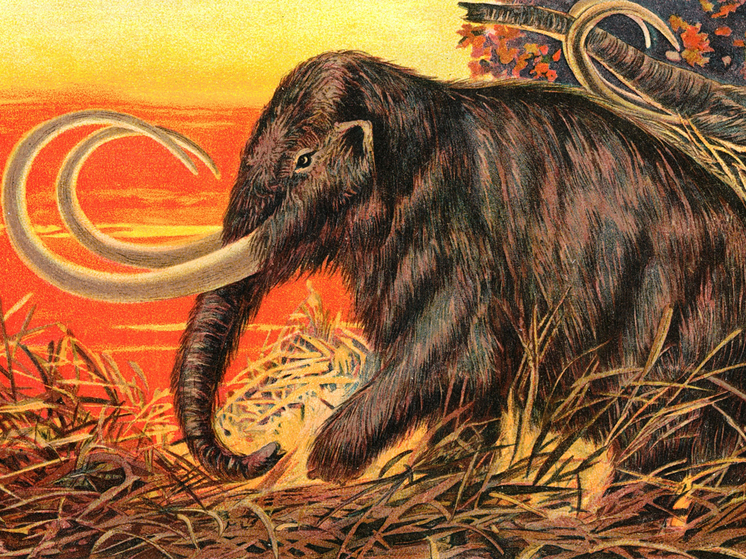«This has never been found before»
A piece of woolly mammoth skin recovered from Siberian permafrost has been found to contain fossilized chromosomes — the first of its kind, according to a new study opening.

Researchers discovered the 52,000-year-old remains in 2018 near the village of Belaya Gora in northeastern Siberia, where cold temperatures helped preserve the structure of chromosomes — tiny thread-like structures that carry genetic material, or DNA, — in great detail, CNN reports.
Although ancient DNA samples have been found many times before, they are typically highly fragmented and contain only hundreds of letters of genetic code. Fossil chromosomes contain millions, giving a much more complete picture of an animal's genetic code.
“Fossil chromosomes have never been found before,” said Erez Lieberman Eiden, professor of molecular genetics and human genetic analysis at Baylor College of Medicine and co-author of the study published Thursday in the journal Cell.
The fragments have also been found in previous studies. there was a lack of orderly structure, Lieberman Aiden added. “Here the fragments are clearly located in 3D format — essentially, the way they were located in the original chromosomes of a living mammoth”.
According to Olga Dudchenko, an associate professor of molecular genetics and human genetic analysis, the chromosomes, which the researchers call «non-mineralized fossils,» are in a state sufficient to assemble a genome, or the sum of all the genetic material of an extinct species.
«We are firmly convinced that this applies not only to mammoths or to this particular species,» CNN quotes Olga Dudchenko as saying, «but, in fact, opens up a new area with enormous potential.»
According to Kevin Campbell, a professor of ecological and evolutionary physiology at the University of Manitoba in Canada, who was not involved in the study, the DNA in different types of cells is presented in distinct and specific three-dimensional structures that provide clues about the specific properties or traits of that cell type.
After death, the body's cells decompose rapidly and this three-dimensional structure is lost within a few days or less, he added. Arctic animals such as the woolly mammoth degrade more slowly due to cold temperatures, but the DNA is still damaged and is expected to lose the structure and characteristics that make up the biology of the species over a long period of time.
«However, this study is the first to demonstrate that this is not always the case,» Campbell wrote in an email.
“DNA is a very, very long molecule, and once it gets there after the animal dies, it starts to decompose and breaks down into shorter pieces,” says Dudchenko.
“Usually you would expect that all these elements will begin to shift relative to each other and will simply float away, losing any organization that was there,” notes Dudchenko. – But it is obvious that in this particular example this did not happen.
This loss of structure is called diffusion, and ways to prevent it are well known to nutritionists — no different than how to prepare beef jerky, she added.
“Slowing diffusion is key to food preservation, so if «You want to keep them in storage for a long time, you essentially need a combination of dehydration and refrigeration,» she said. “Any food that is not canned is likely to be in a state of diffusion inhibition.
When the mammoth from which the skin sample was taken died, conditions may have been favorable for this process to begin naturally. “The carcass could have spontaneously undergone the same procedure that we now constantly use for commercial purposes,” says Dudchenko. — Which allowed us to remove a significant amount of water, stop the diffusion inside and fix these chromosome fragments in place, which allowed us to read them 52,000 years after this happened.
But although it was well preserved, the DNA was not completely intact. “Each chromosome, originally a single DNA molecule, split into millions of DNA molecules,” Aiden wrote in an email. “But other than that, the molecules haven't changed much, even on the nanometer scale, which is why we call it a fossil chromosome.
According to Lieberman Eiden, if the sample were a book, the binding would have been lost, leaving a large number of loose pages or DNA fragments. Diffusion is like the wind, which carries away the pages without giving them the opportunity to put them in order. But in this example the pages didn't fly apart; they remained in a neat stack, just as they had before the binding was lost.
Researchers confirmed this preservation theory by conducting several experiments with beef jerky to see how much they could spoil the meat snack before the chromosomes inside it will lose their structure.
“We decided to test how this wonderful molecule can resist stress and harmful influences by asking one of the pitchers from the Houston Astros.” throw a fastball at her and shoot her with a shotgun,” said Dr. Cynthia Perez Estrada, co-author of the study and a postdoctoral fellow at the Center for Genomic Architecture at Baylor and the Rice Center for Theoretical Biological Physics.
“The beef jerky was breaking down more and more, but the DNA structure was still there, which tells us that DNA is extremely stable, especially in this glassy state (like in the sample) where the molecules are basically frozen and behave like crystals.” , added Perez Estrada.
Thanks to newly discovered genetic information found in skin samples, researchers were able to determine for the first time that the woolly mammoth had 28 pairs of chromosomes, just like modern elephants.
But the structure allowed them to take it one step further and see which individual genes were active in the animal. “Everyone wants to know what exactly made him woolly,” Dudchenko said, “and we have some ideas thanks to the way these chromosomes were preserved.”
The researchers were able to compare individual genes from the mammoth sample with similar genes to modern elephants, noting differences in the activity of genes that regulate hair follicles. But elephant DNA was also needed to make up the mammoth genome.
“Our dream and hope was to completely assemble the mammoth genome, but at the moment this is not exactly what we are striving for— we were still using some information from its immediate family to help, because the amount of data we were able to obtain from the mammoth was less than what would normally be required”, – Olga Dudchenko emphasizes. – But the fundamentals tell us that if we continue to work in this direction, we can do it (without the help of elephant DNA).
Could fossilized chromosomes make the dream of resurrecting the woolly mammoth a reality? “The fundamental biology that we learn from this will be useful, there is no doubt about it,” Dudchenko said. “Are we getting closer? One step closer, but there are still many steps ahead and many other considerations beyond basic science.
The researchers also hope that the same methodology used to study the mammoth sample can be applied to the samples other types.
“We hope to find chromosomal structures in museum samples,” said Marcela Sandoval-Velasco, a visiting researcher at the Center for Evolutionary Hologenomics at the University of Copenhagen in Denmark and co-author of the study. — Not only permafrost samples, because this significantly narrows the search, but also samples from museum collections. There's a lot of potential there,» she added, citing the woolly rhinoceros, extinct lions and the passenger pigeon as among the endangered species that scientists could learn more about this way.
Perez Estrada said the potential opens doors for further discoveries.
“It will take a huge effort to find suitable samples, so there will be a lot of work ahead, but I would not be surprised if we then discover something new and completely different from what we have we exist now,” she said. “It's also a really exciting open question: what else and what other physical properties (of DNA) might be preserved?”
Researchers who were not involved in the study expressed enthusiasm for the results.
The study is the first to reconstruct the structure, or architecture, of the genome of an extinct species that lived during the last ice age, according to Peter Heintzman, a paleogeneticist at Stockholm University in Sweden. “This structural information provides insight into functions of the woolly mammoth genome that were invisible using previous genomic methods,” Heintzman said in an email. “This progress thus helps open up new and exciting frontiers in paleogenomics, the study of ancient genomes, and is likely to provide further insight into how extinct species evolved, lived, and died.”
Because of how much DNA from ancient samples was degraded and fragmented, it was surprising to see the high-quality reconstruction of the mammoth genome at the chromosomal level that this study reported, said Dmitry Filatov, professor of biology at the University of Oxford.
&ldquo “Even more amazingly, the researchers were able to determine which genes were active and which were turned off in the mammoth sample, and compare this with gene expression in elephants,” Filatov wrote in an email. “This will certainly stimulate further paleogenomic studies of other species.”
Hendrik Poinar, director of the Center for the Study of Ancient DNA at McMaster University in Ontario, called the work “very interesting.” Typically, researchers working with fossils can't do anything that even remotely resembles genome assembly, Poinar said.
“I don't know how many tissue samples will be preserved at this level, he added in email — but I think this method will force us to think about new ways to extract DNA from tissue in ways different from what we are used to.






















































Свежие комментарии